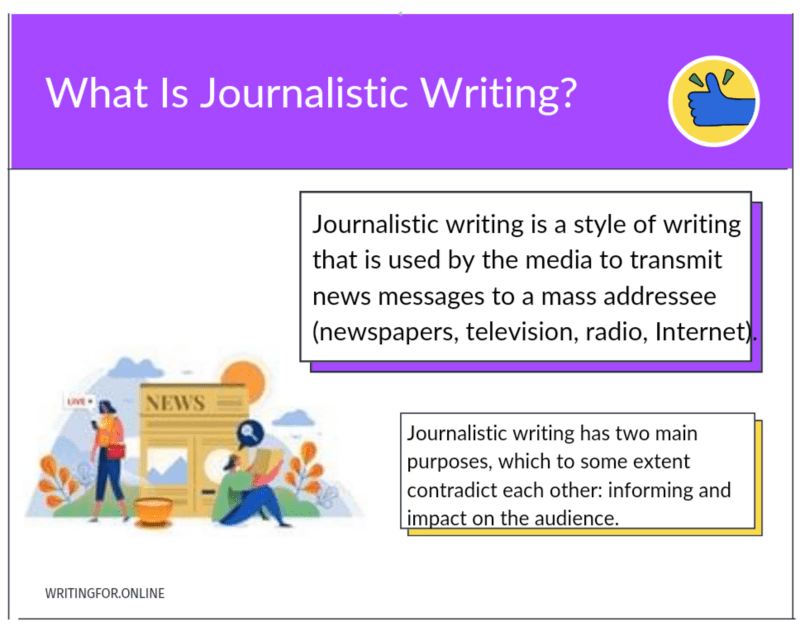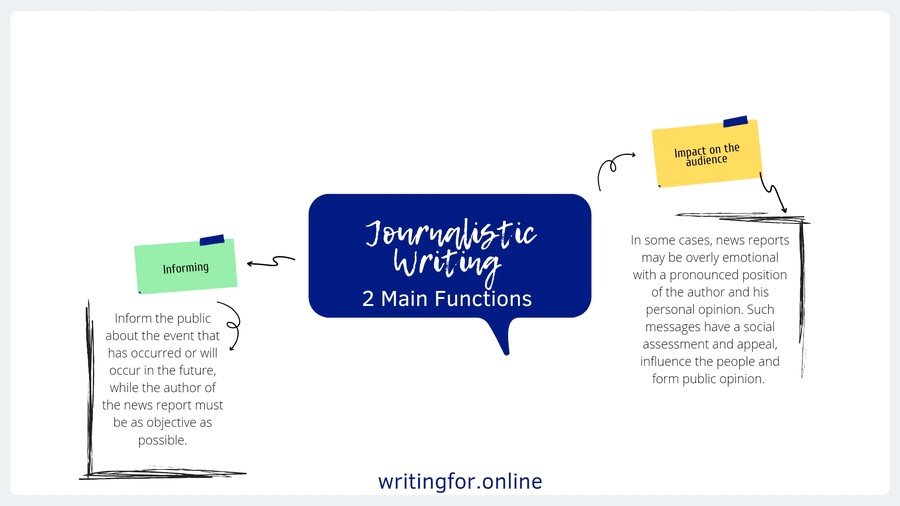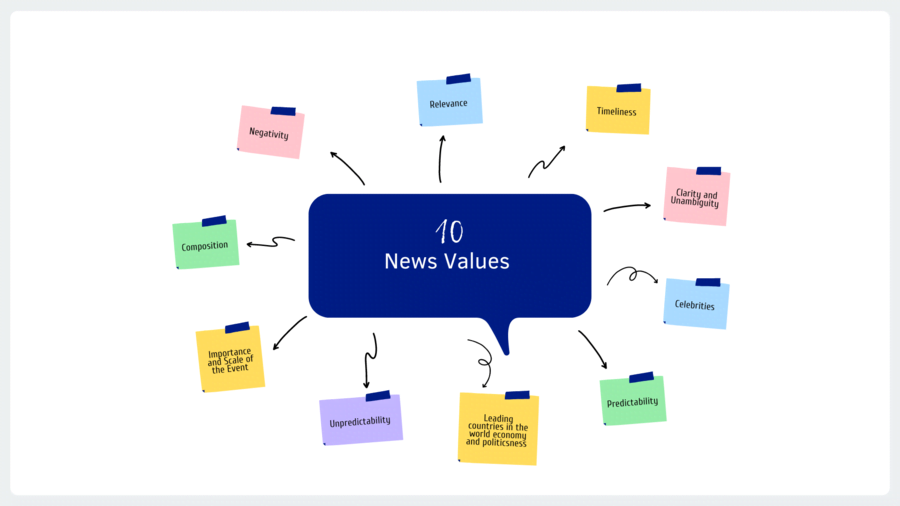Further in the article, you will learn about what journalistic writing is, its main purpose, what are the features and characteristics of journalistic style, get acquainted with three types of journalism, and at the end of the article, you will find information about how the media select news.
Not so long ago, people could get news only from local newspapers, radio, and television. Nowdays we have access to any information in any format 24/7 (thank you, Internet!).
The ways of obtaining information have changed, but the principles and features of journalism have remained the same.
What Is Journalistic Writing, and Its Main Purpose
Journalistic writing is a style of writing that is used by the media to transmit news messages to a mass addressee (newspapers, television, radio, Internet).

Journalistic writing has two main purposes, which to some extent contradict each other:
- Informing. The main aim of journalistic writing is to inform the public about the event that has occurred or will occur in the future, while the journalist must be as objective as possible.
- Impact on the audience. In some cases, news reports may be overly emotional with a pronounced position of the author and his personal opinion. Such messages have a social assessment and appeal, influence the people and form public opinion.

Features of Journalistic Writing
Journalistic writing has some specific features by which it is easy to identify:
- Informative heading. The news headlines are quite long. From the title, it is clear what will be discussed in the news article.
- The first sentence (paragraph or lead) summarizes the essence of the news.
- The inverted pyramid principle. The priority, value, and usefulness of information decrease from the beginning of the text to its end.
- Sentences and paragraphs are mostly short.
- Lots of specifics and details.
- Readability, simplicity, competent presentation of information.
- Emotionality and evaluation.
- Frequent use of socio-political vocabulary (names of political parties, departments, economic and legal terms, etc.).
- Focus on a mass audience.
- Rhetorical questions, exclamations, and repetitions.
- In addition to the main colloquial (informal) style used in journalism, there are slang and jargon words.
Read also:
- post “What Is Scientific Writing Style: Characteristics, Types, and Examples”.
- “What Is Business Writing Style: Characteristics, Types, and Examples”.
How to Write a Journalistic Text: 3 Key Elements
There are three key components on which any journalistic text is built:
- Lead (or lede). This is the first sentence or main and opening paragraph of the news article. The lead is the “header” of the article, which outlines the main idea of the text. Often the lead is highlighted in a different font or color, usually, its length is from 3 to 5 lines of text.
Lead cannot be ignored. It can be sensational or dramatic, it can reveal the details of an event or briefly describe the news, it can amuse the reader or challenge him.
A news article lead looks like this:
“Rescue operations are continuing in South Africa in an effort to save the lives of dozens of people who are missing following the floods in KwaZulu-Natal province. With more rain on its way, emergency teams face further peril as they search for survivors. “
bbc.com
2. Citation. 90% of all journalistic investigations are based on interviews or other primary sources. Therefore, it is not surprising that quotes have a special place in news reports.
Read also post “How to Write a Persuasive Article or Essay: Examples of Persuasive Argument”.
3. Brevity and readability. Sentences and paragraphs are short and simple. It does not mean that you will not find long compound sentences in the text. But in most cases – “brevity is the soul of wit.”
In addition, it is important not to overdo with terms. Still, the news articles should be understandable to the mass audience: if you used the term “legal nihilism”, be kind, and explain what it means (p.s.: legal nihilism is the denial of laws and rules/norms of behavior).
Journalism Genres and Types of Journalistic Writing
There are three genres of journalistic writing:
- Informational: reportage, interview, information note, informational report. The main function is to communicate information: what, where, when, and under what circumstances it happened or will happen.
- Analytical: conversation, review, article, survey, correspondence. The primary function is to influence the public. There are the author’s reasoning, argumentation, analysis of the event, personal conclusions, and assessment of what is happening.
- Artistic-journalistic: essay, feuilleton, pamphlet, profile essay. These genres used to get a figurative, emotional idea of an event or fact.
Let’s take a closer look at each genre.
Information Genre and Its Types
Note as a Type of Journalistic Writing
A note is a short message about a new event or fact. The main features are the reliability of the fact, novelty, and brevity.
Example:
“The Duke and Duchess of Cambridge were accompanied by two of their children as they joined other royals for the Easter Sunday service at Windsor Castle.
Prince George was dressed in a dark blue suit like his father while Princess Charlotte’s dress matched her mother Catherine’s light blue outfit.
Several of their second cousins, such as Mia Tindall and Savannah and Isla Phillips, also attended.
The Queen was not at the service – one of the staples of the family’s year.
The 95-year-old monarch, who has been suffering mobility issues recently. was also absent from the traditional Maundy Service last Thursday where special coins were given to 96 men and 96 women.”
bbc.com
Read also “How to Write a News Story”.
Reportage
Reportage is a message from the scene. Features: efficiency, objective coverage of events, the reporter is an eyewitness or participant in what is happening.
Example: television report (live broadcast from the scene), report in the print media after collecting and processing information.
Interview
An interview is the receipt of information during a conversation between an interviewer (journalist) and an interviewee.
Examples: informational interviews to collect up-to-date data on an air crash that has occurred (for example, an interview with eyewitnesses); interview investigation; personal interview or interview-portrait.
Informational Report
A report is a chronologically sequential, detailed report of an event.
Example: a report on hostilities, a report on the results of a meeting, a conference, a government or court session.
Analytical Genre
Conversation or Dialogue
A conversation (dialogue) is a type of interview when a journalist acts not just as an intermediary between the hero and the viewer, but communicates with the interlocutor on an equal footing thanks to his achievements, experience, and professionalism.
Example: TV show with artists.
Review
A review is a critical judgment or discussion that contains an assessment and a brief analysis of a literary work, scientific publication, analysis of a work of art, journalism, etc.
Examples: book review, play review, movie review, TV show review, game review.
Article
An article is a genre of journalism that expresses the author’s reasoned point of view on social processes, on various current events or phenomena.
After reading an analytical article, the reader receives the information he needs and then independently reflects on the issues of interest to him.
The subject of the article is not the event itself, processes, or phenomena, but the consequences they cause.
Examples: an article on the political development of the country, a practical and analytical article on the rise in food prices, a polemical article (dispute) on teaching the basics of Orthodox culture.
Analytical Correspondence
Analytical correspondence is a message that gives information about an event or phenomenon (usually this is one significant fact).
Analytical correspondence may include fragments of a “live” report or a retelling of what is happening. But necessarily in such a message, there is a clarification of the causes of the event or phenomenon, the determination of its value and significance for society, and the prediction of its further development.
The primary source of this genre of journalistic writing is always the author of the publication (correspondent).
Artistic-journalistic Types of Journalistic Writing
Essay
Essay: a journalist not only describes a problem, an event, or a portrait of a person, based on factual data but also uses artistic methods of expressiveness.
Examples: a portrait essay about the life of a famous person; historical essays, description of incidents, meetings with people during the author’s travel (essay by A. S. Pushkin “Journey to Arzrum”, 1829).
Feuilleton
Feuilleton is a short note, essay, or article of a satirical nature, the main task of which is to ridicule “evil”.
Examples: satirical writers such as M.E. Saltykov-Shchedrin, I.A. Ilf, and E.P. Petrov.
Pamphlet
A pamphlet is a satirical work or article, the purpose of which is to ridicule certain human vices, to denounce and humiliate a hero who appears to the author as a carrier of a dangerous social evil.
In a pamphlet, the author uses grotesque, hyperbole, irony, and sarcasm.
Examples: “Lettres provinciales” by the French scientist and philosopher Blaise Pascal, “The Grumbled Hive” by the English writer Bernard Mandeville, pamphleteers D.I. Pisarev with the pamphlet “Bees”, A.M. Gorky “The City of the Yellow Devil”, L.M. Leonov “The Shadow of Barbarossa”.
10 News Values
First of all, journalistic writing is associated with the media. A special place in the mass media is occupied by news articles: they are in demand and attract more readers.
Therefore, I propose to pay attention to one very interesting point: how is a news article written, and by what criteria are news “selected”?

So, 10 news values are:
- Relevance. The news must meet the needs and interests of the audience.
- Timeliness. Event information must be up to date and appear on time. No one will read the election results two weeks after the election.
- Clarity and unambiguity. Simple, understandable news is more accessible to the public, read more often, and is more interesting.
- Predictability. Significant events usually have specific dates (for example, election day, the opening ceremonies of the Olympic Games, the football championship). Therefore, with the approach of such an event, public interest increases, and the news becomes more valuable.
- Unpredictability. On the other hand, unpredictable events and phenomena (natural disasters or crimes) also arouse public interest.
- Importance and scale of the event. War, elections, protests, sports games, and other important events require long and detailed press coverage.
- Composition. Sometimes, to dilute, for example, the negativity of the information flow, the editor selects news reports of the opposite nature: funny cases, love, romance, salvation, animals, adventure, risk, etc.
- Celebrities. News with the participation of politicians, artists, and sportsmen, due to their status and recognition, is more often published in the media and arouses increased interest.
- Leading countries in the world economy and politics. A strike, a natural disaster, or a plane crash in a developed country will immediately hit the media. But about the lack of drinking water in Ethiopia, you can write later.
- Negativity. The “bad” news is more popular.
P. S.: Did you like this post? Share it with your friends, thank you!